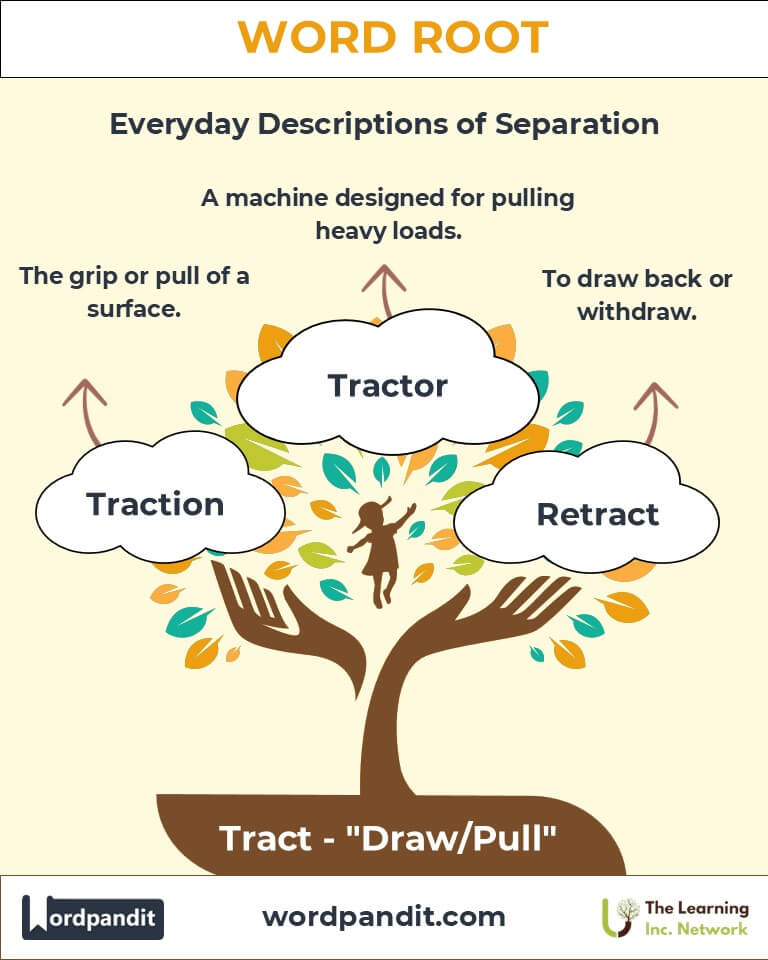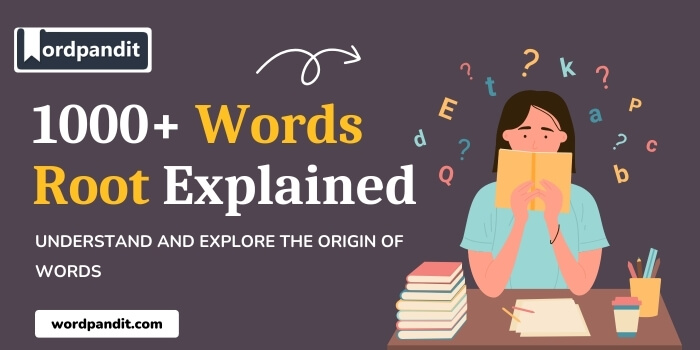Tract: The Root of Motion and Influence in Language
Byline: Discover the versatility of the word root "tract," derived from Latin, meaning "draw" or "pull." From powerful machines like tractors to the elegance of abstraction, this root shapes a variety of words that describe movement, attraction, and persuasion in everyday life and specialized fields.

Table of Contents
- Introduction: The Essence of "Tract"
- Etymology and Historical Journey
- Mnemonic: Unlocking the Power of "Tract"
- Common "Tract"-Related Terms
- "Tract" Through Time
- "Tract" in Specialized Fields
- Illustrative Story: "Tract" in Action
- Cultural Significance of "Tract"
- The "Tract" Family Tree
- FAQs About the "Tract" Word Root
- Test Your Knowledge: "Tract" Word Root Quiz
- Conclusion: The Living Legacy of "Tract"
1. Introduction: The Essence of "Tract"
Imagine the power to pull ideas, emotions, or physical objects toward you—this is the essence of the root "tract." Pronounced "trakt," it comes from the Latin verb trahere, meaning "to draw" or "to pull." Words derived from this root describe both tangible motion, as in a "tractor," and abstract influence, as in "attraction." Across disciplines, "tract" adds depth to our understanding of motion, influence, and relationships.

2. Etymology and Historical Journey
The root "tract" originates from the Latin trahere, evolving into tractus, meaning "pulled" or "drawn." It entered English through Old French during the Middle Ages, enriching vocabulary with terms that reflected physical and metaphorical movement. Over centuries, "tract" has adapted to describe everything from machinery to philosophy.
3. Mnemonic: Unlocking the Power of "Tract"
To remember "tract," picture a tractor pulling a heavy load across a field. This powerful image connects the root to its meaning—drawing, pulling, or influencing.
Mnemonic Device: "Tract attracts motion and thought, from tractors to contracts."
4. Common "Tract"-Related Terms
- Tractor (trak-tur):
- Definition: A machine designed for pulling heavy loads.
- Example: "The farmer used a tractor to plow the fields."
- Subtract (sub-trakt):
- Definition: To draw away or take something out.
- Example: "If you subtract three from ten, you get seven."
- Attract (uh-trakt):
- Definition: To draw something or someone toward oneself.
- Example: "The flowers attract bees with their vibrant colors."
- Contract (kon-trakt):
- Definition: An agreement drawn between parties.
- Example: "Both sides signed the contract after negotiations."
- Distract (dis-trakt):
- Definition: To draw attention away from something.
- Example: "The loud noise distracted her during the meeting."
5. "Tract" Through Time
- Retract (Middle Ages): Derived from Latin retractare, meaning "to draw back," the term initially described physical withdrawal but now includes metaphorical uses, like retracting a statement.
- Abstract (Renaissance): From the Latin abstractus, meaning "drawn away," this term emerged to signify conceptual or theoretical ideas.
6. "Tract" in Specialized Fields
- Medicine:
- Tract: Refers to pathways in the body, such as the digestive tract.
Example: "The digestive tract plays a vital role in nutrient absorption."
- Tract: Refers to pathways in the body, such as the digestive tract.
- Law:
- Contract: A legally binding agreement.
Example: "The contract outlined the responsibilities of both parties."
- Contract: A legally binding agreement.
- Engineering:
- Traction: The grip or pull of a surface.
Example: "The tires provided excellent traction on the icy road."
- Traction: The grip or pull of a surface.
- Psychology:
- Attraction: The force that draws individuals together.
Example: "Her cheerful demeanor created instant attraction."
- Attraction: The force that draws individuals together.
7. Illustrative Story: "Tract" in Action
Elliot, a young engineer, designed a groundbreaking tractor capable of pulling enormous loads while consuming minimal fuel. During its debut, he explained how its superior traction ensured stability even on uneven terrain. Meanwhile, his persuasive speech attracted investors who helped fund the tractor's mass production, proving that "tract" influences both the physical and the abstract.
8. Cultural Significance of "Tract"
The concept of pulling or drawing has symbolic significance across cultures. From magnetic attraction in science to the pull of destiny in literature, "tract" illustrates forces that shape relationships, decisions, and movements.

9. The "Tract" Family Tree
- Duc/Duct (to lead or pull):
- Conduct: To lead or guide.
- Deduce: To draw a conclusion.
- Pon/Pos (to place or put):
- Oppose: To place against.
- Propose: To put forth an idea.
- Tend/Tens (to stretch):
- Extend: To stretch out.
- Intend: To stretch one's mind toward a goal.

10. FAQs About " Tract "
Q: What does "tract" mean?
A: "Tract" comes from the Latin trahere, meaning "to draw" or "to pull." It serves as the basis for words describing motion, influence, and connections, both physical and abstract.
Q: How is "tract" used in medicine?
A: In medicine, "tract" refers to a pathway or system that transports substances or signals. For instance, the digestive tract processes food, while nerve tracts in the spinal cord transmit signals.
Q: What is the origin of the word "tractor"?
A: "Tractor" derives from "tract," meaning "to pull." It specifically refers to a machine designed to pull heavy loads, highlighting its root function of drawing or pulling.
Q: What is the difference between "attract" and "distract"?
A: Attract means to draw something or someone toward you, often through appeal or influence. Distract means to pull attention away from something, often causing a lack of focus.
Q: What does "subtract" mean, and how is it related to "tract"?
A: "Subtract" means to take away or draw away a portion. It combines the prefix sub- (under) with tract (pull), signifying the act of pulling a part out of a whole.
11. Test Your Knowledge: " Tract " Mastery Quiz
1. What does "tract" mean?
2. Which word means "to pull something away"?
3. What is a "contract"?
4. What does "distract" mean?
5. Which term refers to pathways in the body?
12. Conclusion: The Living Legacy of "Tract"
The root "tract" is a cornerstone of language, describing physical, emotional, and intellectual movement. From machinery that powers agriculture to abstract concepts that shape thought, "tract" embodies the power of pulling and drawing connections. As language evolves, this root will continue to inspire and inform new words that reflect our dynamic world.












